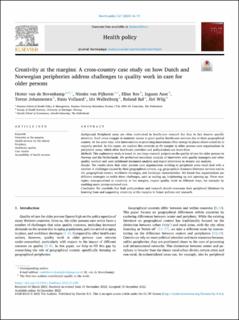| dc.contributor.author | van de Bovenkamp, Hester | |
| dc.contributor.author | van Pijkeren, Nienke | |
| dc.contributor.author | Ree, Eline | |
| dc.contributor.author | Aase, Ingunn | |
| dc.contributor.author | Johannessen, Terese | |
| dc.contributor.author | Vollaard, Hans | |
| dc.contributor.author | Wallenburg, Iris | |
| dc.contributor.author | Bal, Roland | |
| dc.contributor.author | Wiig, Siri | |
| dc.date.accessioned | 2023-02-16T09:19:47Z | |
| dc.date.available | 2023-02-16T09:19:47Z | |
| dc.date.created | 2023-01-09T13:16:02Z | |
| dc.date.issued | 2022 | |
| dc.identifier.citation | van de Bovenkamp, H., van Pijkeren, N., Ree, E., Aase, I., Johannessen, T., Vollaard, H., Wallenburg, I., Bal, R., & Wiig, S. (2023). Creativity at the margins: A cross-country case study on how Dutch and Norwegian peripheries address challenges to quality work in care for older persons. Health Policy, 127, 66-73. | en_US |
| dc.identifier.issn | 0168-8510 | |
| dc.identifier.uri | https://hdl.handle.net/11250/3051366 | |
| dc.description.abstract | Background
Peripheral areas are often overlooked in health-care research but they in fact deserve specific attention. Such areas struggle to maintain access to good quality health-care services due to their geographical context. At the same time, new interventions or promising innovations often emerge in places where creativity is urgently needed. In this paper, we explore this creativity at the margins in older persons care organizations in peripheral areas, which other healthcare providers and policymakers can learn from.
Methods
This exploratory study is based on two large research projects on the quality of care for older persons in Norway and the Netherlands. We performed secondary analysis of interviews with quality managers and other quality workers and used additional document analysis and expert interviews to deepen our analysis.
Results
The results show that older persons care organizations working in peripheral areas must deal with a number of challenges caused by their geographical context, e.g. geographical distances (between services and to the geographical center), workforce shortages, and landscape characteristics. We found that organizations use different strategies to tackle these challenges, such as scaling up, brightening up and opening up. These strategies, conceptualized as creativity at the margins, impact quality work in different ways, for example by enabling more person-centered care.
Conclusion
We conclude that both policymakers and research should overcome their peripheral blindness by learning from and supporting creativity at the margins in future policies and research. | en_US |
| dc.language.iso | eng | en_US |
| dc.publisher | Elsevier | en_US |
| dc.rights | Navngivelse 4.0 Internasjonal | * |
| dc.rights.uri | http://creativecommons.org/licenses/by/4.0/deed.no | * |
| dc.title | Creativity at the margins: A cross-country case study on how Dutch and Norwegian peripheries address challenges to quality work in care for older persons | en_US |
| dc.title.alternative | Creativity at the margins: A cross-country case study on how Dutch and Norwegian peripheries address challenges to quality work in care for older persons | en_US |
| dc.type | Peer reviewed | en_US |
| dc.type | Journal article | en_US |
| dc.description.version | publishedVersion | en_US |
| dc.rights.holder | The authors | en_US |
| dc.subject.nsi | VDP::Medisinske Fag: 700 | en_US |
| dc.source.volume | 127 | en_US |
| dc.source.journal | Health Policy | en_US |
| dc.identifier.doi | 10.1016/j.healthpol.2022.12.008 | |
| dc.identifier.cristin | 2103275 | |
| dc.relation.project | Norges forskningsråd: 256681 | en_US |
| dc.relation.project | SHARE - Centre for Resilience in Healthcare: 5091 | en_US |
| cristin.ispublished | true | |
| cristin.fulltext | original | |
| cristin.qualitycode | 2 | |

